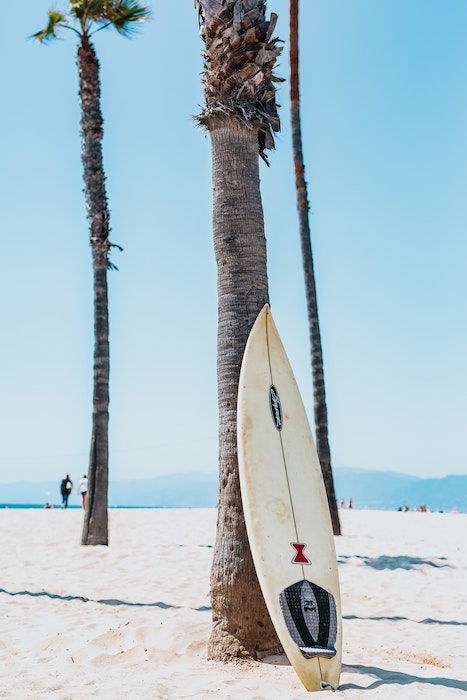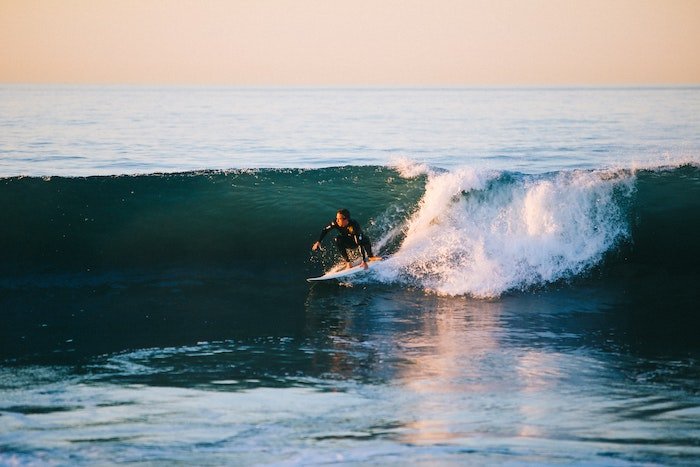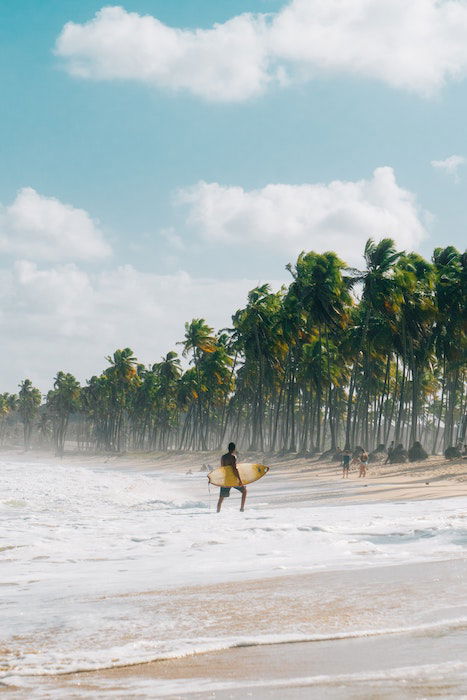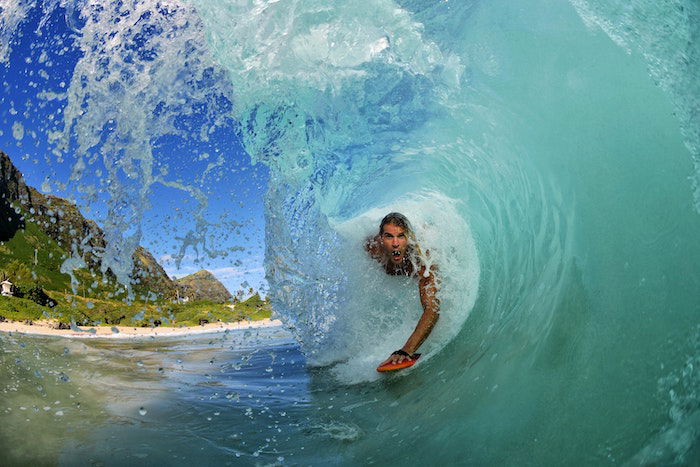Whether you like to surf or not, diving into surf photography can be inspiring and rewarding! It’s also a challenge and will test your technical knowledge and creativity.
We’ve all seen those picture-perfect shots of a surfer in a barrel or riding a wave. Even before you add in the setting sun or a dramatic background, they look fantastic. But how do you take good surf pictures?
Tips for Taking Great Surf Photography
Surf photography is full of technical challenges. You’ll need to be aware of light, shooting direction, and shot composition. There are also physical considerations, like the fact you’ll be shooting so close to or on the water. Despite this, it’s a subject full of opportunities for getting epic action shots.
Coastlines and beaches are perfect for dynamic, dramatic shots ideal for inspiration. Before getting great shots of surfers, you can practice the technique. And don’t worry, you don’t need to be a surfer to take great surf photos. While surfing knowledge will help, it’s not a barrier to success.
To help you get started, we’ve put together some tips for incredible surf photography. You’ll also find some ideas for water photography and underwater photography. If you want to become a surf photographer, let’s ride the wave together!
Experiment With Your Composition
It’s best to balance action with the stunning background of your image. Consider how the surfer will draw the viewer’s eye. Is there a pier or rocky outcrop you can frame them against? Can you play with perspective with sea cliffs, ships, or giant waves?
If you’re shooting big wave surfing, for example, you can emphasize the size of the wave compared to the surfer. Consider the angle of your shot—this can create drama and scale in your composition. You should also consider light and its effects.
Try to avoid unnecessary distractions in your image. You don’t want objects directly behind your subject, as this will detract from the effect. Avoid things such as masts, buoys, or other surfers merging with the outline of your subject.

Tell a Story
You can create a great story with surf action. There’s plenty of movement when working with water. But, if you don’t position your subject correctly, you could get boring-looking images.
By positioning subjects on the left or right of the frame, surf photographers create a sense of direction. Your images will capture where your subject has been and where they are heading. Combined with the natural movement of breaking waves, you’ll get dynamic photos.
Avoid centering the surfer in your shot. This can create a flat image and can leave the viewer wanting more. If you’re shooting several subjects, create movement between them. Also, consider what else you include in your shot. Where have the surfers been? What is the context? Where are they heading?
Shooting from within a barreling wave or angling your shot to reflect the crest creates a great story.

Use the Light
As with many other types of photography, light is one of your best tools in surf photography. It can affect the mood, energy, and tone of your images. Adapt to what you have. If you’re shooting around dusk, go for dramatic, striking compositions. Consider incorporating a storm into your angles and composition if a storm is on the horizon.
If you have intense, bright light, it can be great to shoot back up through the water. A breaking wave can look amazing if it’s captured with light behind it. If you use a fast enough shutter speed, you can capture textures beautifully.
Low sun angles mean you can play with silhouettes and shadows if you shoot later in the day. You’ll be able to take snapshots full of emotion, depth, and meaning. This can also look great with soft reflection! Be sure to keep an eye on your exposure settings.

Use The Foreground
Sometimes, the action isn’t as dramatic as you may want. To give your shots depth and perspective, don’t neglect the foreground. Like an exciting background, having interesting or striking objects in the foreground is vital.
Remember that shooting straight on can be tedious. By shooting along a beach or at an angle from rocks, you can include extra features. Making use of your foreground can breathe life into your photos.
Experiment with trees, beachgoers, or surfers heading out into the water. You might even be lucky if wildlife enters the frame.

Stay Stable
If shooting from land, you should use a tripod or monopod. If you’ve gone manual with your settings, this will improve your stability. It also makes shooting with longer lenses easier and can help you get sharp, well-composed images.
Using a tripod also makes it easy to track surfers and the direction of the wave. This helps you keep your shot composition and create movement in your images. You’ll also be able to align your tripod with the horizon—key for getting great surf photos.
Lightweight tripods and monopods are an excellent choice for the beach or rocks. You’ll want to remain mobile, so being able to pack up and move without fuss should be considered. Don’t just stay in one spot!

Steady The Horizon
This is an aesthetic choice and can completely change the composition of your image. It’s not a rule that’s limited to surf photography. If you’re not doing it on purpose, you should always be sure to keep the horizon steady and level in your shots.
Images with a skewed horizon can look strange, as they will draw the eye of your audience. The human brain unconsciously processes what we see and knows when something is off. Unless you’re planning on creative edits or surreal shots, your images will look strange.
Ultimately, it’s your choice, as your photography should be a way for you to express yourself. But bear in mind the effects it may have.

Don’t Only Think About Action
While the main draw is the classic shot of a rider catching a wave, there’s more out there. The locations alone offer the opportunity for great landscape shots. You’ll also get fantastic color and dramatic skies if you’re shooting at dawn or dusk.
Surfing is more than a sport—it’s a lifestyle, and you should expand your story to include life out of the water. Snap people relaxing or preparing to head out into the surf. You could even snap some portraits and add personality to your story.
A good surf photographer captures the journey a surfer takes from the beach. Tell the story of paddling out and catching a wave.

Time to Get Wet
While shooting from the shore can yield fantastic results, there are other options. With the right equipment, you can shoot from the water itself. Everyone loves the classic shot of a surfer riding inside the barrel of a wave.
If you want to head into the surf, buy a reliable camera water housing. It’s also best to familiarize yourself with the basics of surfing. You should know where to position yourself and when to shoot.
Shooting from the water offers extra chances for creativity. You can incorporate water into the edges of your photo. Half-submerged subjects create exciting dynamics. Shooting detailed images of the waves and water is easier when you’re right up close!

Go For Manual Mode
To help keep your images crisp, you’ll want to stick with a higher shutter speed. This will help you snap great action shots, complete with water spray and fine detail. Most surf photographers use TV mode or go fully manual if in the water.
Surfing is a dynamic sport, which can result in blurred photos and a lack of clarity. Shooting with a shutter speed of 1/700 and above will allow you to capture emotion, movement, and reactions in perfect sharpness.
It would help keep your ISO low to minimize noise in your shots. This is where your tripod will become essential. Low ISO will help you maximize image quality.
In this way, you’ll create a great visual draw in your image. It can also help enhance your composition. It will also generate direction and contrast. If you don’t want to go for full manual mode, shutter priority mode is perfect for dynamic surf shots. This is also known as TV mode. You can adjust shutter speed while your camera handles exposure in this mode.

Consider a Polarizing Filter
If you’re shooting on a bright, sunny day, you’ll have to deal with reflections. As the bright sun hits the water, you’ll get reflections on the surface and in the spray. You can minimize this in your shots by using a polarizing filter. These filters manage the balance of light entering your lens. Just be sure to use the correct size filter for your lens.
With deep color and sharp, intense spray, you’ll get great results. Your shots may look overly bright without a polarizing filter, and water loses clarity. A polarizing filter is a valuable tool for many other situations in photography, so keep one in your bag!

Expand Your Surf Knowledge
While it’s unnecessary, knowing a little about surfing helps you plan. Different styles of surfing offer various opportunities. You’ll also find it easier to anticipate action and direction if you have prior knowledge. You’ll know what, when, and how to shoot.
It often pays to connect with your subjects to capture images of life on the beach. If you can display a passion for surfing and photography, opportunities will open up.
When shooting in the water, stay safe. If you’re unaware of the dynamics of surfing, you could be in harm’s way. In this situation, a little knowledge is a must. Surf is different around the world, so different approaches apply!

Choose the Right Lens
You may be unsure what lens you should use for surf photography. This depends on your approach and what type of shot you want. If you want close-up, intense photos of the action, a lens of 400mm and up works great. You’ll get detail-heavy, sharp images, even from a distance with a long lens.
If you want pulled back, less intimate shots, lenses such as a 70-200mm lens are perfect. You can incorporate foreground and background and also capture more surrounding life.
More creative lenses like fisheye or wide-angle lenses work really well if you shoot in the water.

Shoot at Dawn and Dusk
Shooting at dawn and dusk is perfect for getting dramatic, color-drenched photos. As the light changes, you’ll get great color palettes and patterns in the sky. This can be a great time to experiment with silhouettes and shadows. You’ll also get great backgrounds with clouds and the open ocean.
You’ll get great light effects in surf spray and beautiful golden and orange tints in the water. If you’re shooting from the water itself, you can snap perfect shots of the light through a breaking wave. Going manual here can help you gather light and focus.
There’s something magical about being on a beach at sunset or sunrise. Make use of the shifting colors and changing light to tell a story. Experiment with the hours before and after sunrise and sunset. You’ll get shots full of emotion and magic.

Capture Epic Action
Catching a surfer getting airtime against the surf looks excellent. If you’re going for action shots, make them as dramatic as possible. Consider your composition to boost angles, heights, and impacts.
Remember to include the human element! People’s reactions and expressions can make your photo seem even more intense. Fast shutter speed and correct exposure are vital for capturing drama.

Avoid Reflections
Before you shoot, study the water. Depending on the time of day and the strength of the light, you’ll get reflections. If you want a photo full of detail and contrast, try to find an angle that minimizes reflections.
Shooting in the evening or morning can increase or decrease reflections on the water. You’ll get incredible detail and color in the water if you take time to position yourself properly!

Think Outside the Box
Don’t just stick to the commonly seen surf shots. These look great, but your photos will stand out if they’re unique. Find a magic angle, or combine techniques to get creative. Suppose you can shoot from the water. You’ll get some impressive results. The unpredictable nature of the sea will offer great opportunities.
Experiment with color. Black and white surf photography looks fantastic. Also, don’t be afraid to travel. The best surf spots may not be within easy distance, but the best shots lay there.

Stay Safe
Safety first! Even if you’re staying on dry land, be sure not to take any risks. Shooting on rocks and coastlines can bring slippery surfaces. Being in the water can expose you to currents and collisions. Make sure you know your surroundings before you shoot!

Conclusion
So, ultimately, how do you take good surf pictures? The answer is all of the above, plus practice! As with all other types of photography, surf photography isn’t always easy. As you get more familiar with surfing, the lifestyle, and the action, you’ll ease into it.
Our list isn’t exhaustive, and you may have your techniques and approaches. Surf photography is all about telling stories. The beauty of this is that you are in control of telling that story. If you’re wondering what cameras are best for surf photography, stick with us. In addition, discover the best surf photographers to follow for inspiration!
Try out some of our tips, and experiment with new techniques, camera types, and locations. You’ll be riding the waves of success in no time, and you’ll become a better photographer!
Check out our Effortless Editing with Lightroom course to ensure your surf photography really makes an impact on your viewers!
